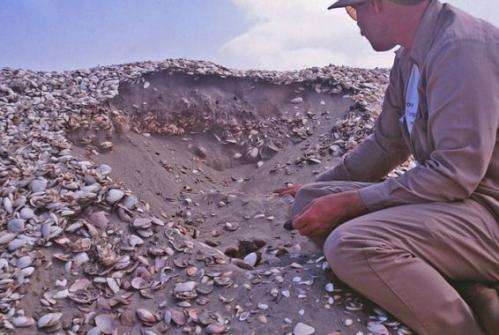May 20, 2014 report
Study indicates Spanish conquest of Peru may have resulted in changes to coastal shoreline

(Phys.org) —A study by a pair of researchers with the University of Maine suggests that the northern coast of Peru may have been altered due to population shifts as a result of the Spanish conquest in the 1500's. In their paper published in Proceedings of the National Academy of Sciences, Daniel Belknap and Daniel Sandweiss describe a field study they conducted in the area that suggested that Inca living on the coast prior to the Spanish conquest, may have inadvertently been supporting the existence of sand ridges by discarding mollusk shells. After they left, it appears, some of the sand ridges were blown away by the wind.
The sand dune ridges along the northern coast of Peru came about, the researchers claim, due to earthquakes loosening sand deposits in the Chira valley. That sand was eventually swept into rivers which carried it to the sea. Currents then carried it north eventually depositing it along the shoreline, building up over time into large ridges. Radiocarbon dating of charcoal remnants from fire pits atop some of the ridges has shown them to have formed from over 5000 years ago to as recently as 400 years ago. Excavating one of the existing ridges, the two researchers report, revealed mollusk shells which because there were so many of them, served as a shield against the wind, which would have blown the sand off the ridges long ago, had not the shells been there to offer protection.
The Inca, the researchers report, lived along the shorelines of northwest South America for thousands of years, catching, cooking and eating mollusks and tossing the shells aside as they sat atop a ridge. The result was millions of shells littering the surface of the ridges, forming armor of sorts, which allowed the ridges to remain intact far longer than they would have otherwise. But, then, the Spanish arrived, conquering the Incas and forcing them to move inland. After that, the shell littering ceased—without a constantly rejuvenated suit of armor, many of the ridges succumbed to the winds and vanished. Thus, the coast was altered in a way that neither the Inca nor their conquerors could have possibly imagined.
More information: Effect of the Spanish Conquest on coastal change in Northwestern Peru, Daniel F. Belknap, PNAS, DOI: 10.1073/pnas.1404568111
Abstract
When Francisco Pizarro and his small band of Spanish conquistadores landed in northern Peru in A.D. 1532 to begin their conquest of the vast Inca Empire, they initiated profound changes in the culture, language, technology, economics, and demography of western South America. They also altered anthropogenically modulated processes of shoreline change that had functioned for millennia. Beginning with the extirpation of local cultures as a result of the Spanish Conquest, and continuing through today, the intersection of demography, economy, and El Niño-driven beach-ridge formation on the Chira beach-ridge plain of Northwestern Peru has changed the nature of coastal evolution in this region. A similar event may have occurred at about 2800 calibrated y B.P. in association with increased El Niño frequency.
Journal information: Proceedings of the National Academy of Sciences
© 2014 Phys.org




















